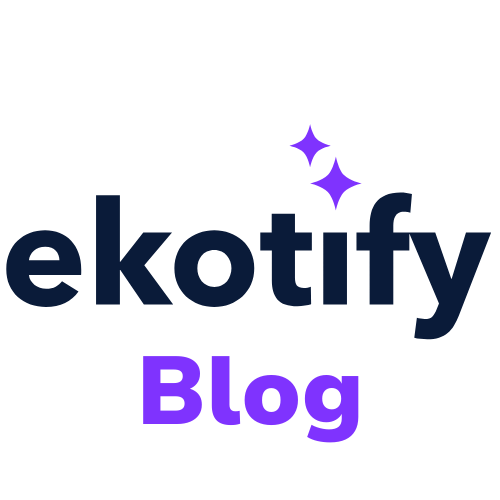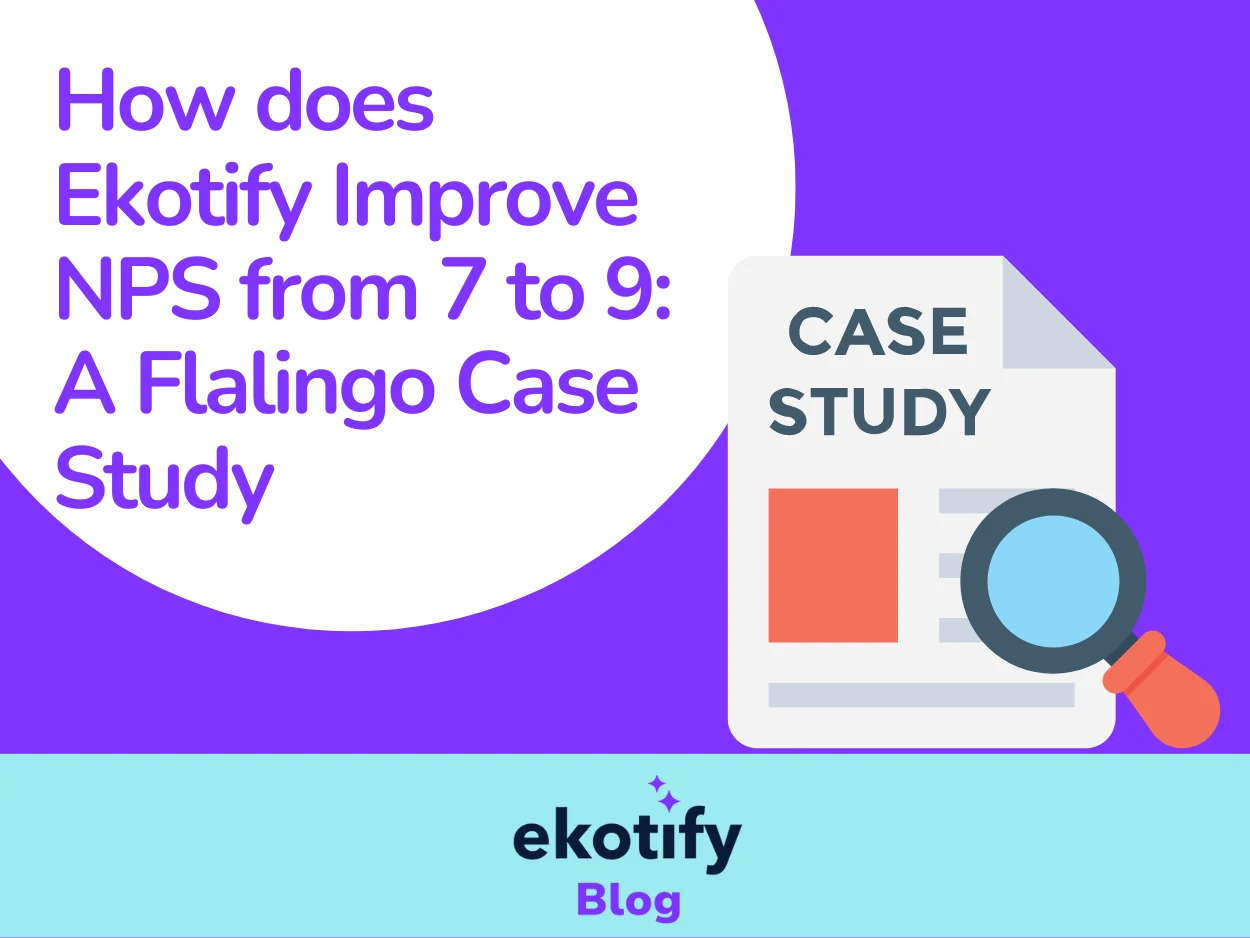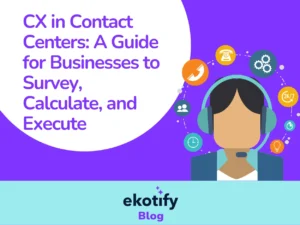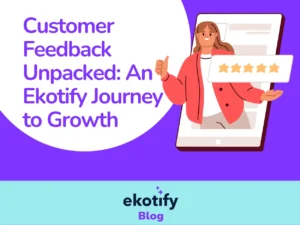The art of Customer Experience (CX) calls for businesses to adopt the approach of mathematicians in issue resolution. By improving relevant statistics with reliable data, business leaders can achieve a thriving and develop long-lasting strategies. Today, we will answer the question, “But how?” with the Flalingo Case Study. In this case study, after introducing Flalingo and its struggle with NPS, we will illustrate how Ekotify managed to improve Flalingo’s NPS from 7 to 9, step by step. Following this, we will explore the positive reflections of the NPS score improvement on Flalingo’s growth.
First Things First: What is an NPS Score and Why is it the Rockstar of CX?
The Net Promoter Score (NPS) is a metric that represents the willingness of your customers to promote your brand to others. Essentially, NPS shows how many of your customers are recommending your services and products, helping you acquire new customers. NPS is measured on a scale from 0 to 10: scores from 0 to 6 are considered detractors, 7 to 8 are passives, and 9 to 10 are promoters. Therefore, it is not an exaggeration to say that NPS measures the strength of the echoes of CX that you present. One of the pivotal aims of every business is to keep the NPS at its peak, regardless of market fluctuations and developments that change customer behavior.
How Does Ekotify Handle NPS Scores and Foster Their Improvement?
Ekotify is an AI tool that helps businesses listen to their customers. Whenever your contact center is in dialogue with a customer, Ekotify gathers customer feedback and breaks it down into reports. In this case, we will highlight Ekotify’s NPS score calculation feature. In conventional methods, NPS calculation is often based on customer assertions, reference links, and yes-no answers to the question, ‘Would you recommend us?’
What Makes Ekotify Unique?
As Ekotify analyzes customer-contact center agent dialogues with AI, there is no additional work for customers just because managers want to find out the NPS score. During the conversation, Ekotify pinpoints the customers’ motivation to promote or not promote your product between the lines with its sophisticated CX analysis carved from technology.
All Onboard Measuring NPS
To measure the NPS score, AI analysis relies on more than customer assertions regarding promotion or detraction. Ekotify heavily appeals to in-context feedback analysis, sentiment analysis, and pain-point detection.
Taking Feedback without Disturbing the Customers
The first advantage of this analysis is that customers are not obliged to give a rating, which can be overwhelming and frustrating. Imagine when a contact center asks you a question or directs you to another line to grade them. Even though it may only take seconds, we are often reluctant to do so. AI analysis eliminates the additional steps and channels to gather feedback as taking the NPS score with feedback in context is possible and effective.
Ensuring that Promoters Aren’t Detractors and Vice Versa
The second benefit is that Ekotify captures the customers’ evaluation as it is, without exaggeration or a random comment just to get rid of the grading phase. Also, even though customers may happily reflect their satisfaction and motivation to promote the brand to others, they may be in a different mental state when grading, or just give a note opposite to their opinion, such as detractors voting as promoters. Because of the awareness of giving a rating, the results may become unnatural. Again, taking customer response out of context removes the suspicions about the reliability of results.
Detecting the Elements Impacting the Score
The third advantage is that yes-no or numerical grading systems are too superficial as they cannot capture the ultimate motivation behind the scoring. For example, a customer can be in a promoter group, yet it leaves room to decide why for the customers. Without knowing the incentives and worries of detractors, passives, and promoters, taking actionable decisions hinges on chance.
Sentiment Analysis Achieved with AI Technology
Another decisive advantage of Ekotify is the sentiment analysis talents that only AI possess. As AI captures the emotion between lines, reports reveal the satisfaction and dissatisfaction, and their place in the spectrum. However, Ekotify does not solely point out who is happy or not. Additionally, with the AI sentiment analysis:
- Are customers happy or not,
- To what extent they are happy or not,
- Why they are happy or not,
- What is the reason behind the expression of happiness or not.
Therefore, businesses can clearly see what is going right and what needs to change to improve CX throughout the organization, as well as handling the NPS score effectively.
Ekotify eliminates the downsides of conventional NPS calculation and reflects customer loyalty and the plausibility of new customer acquisition thanks to effortless AI analysis. In short, Ekotify captures the intention of customers regarding promotion or detraction instantly during the natural flow of conversation and presents it in reports to managers.
Introducing Flalingo: The Protagonist of This Case Study
Flalingo is an Edtech startup that emerged among the competitive online English tutoring apps in 2021. Flalingo offers high-quality English course content through a distance learning model with various tutors from around the world. However, Flalingo is most active in Turkey and Saudi Arabia and offers various contact channels, such as social media, WhatsApp, email, live chat on the website, and most importantly, voice calls, due to the communication habits of customers. Compared to its competitors, users favor Flalingo for its convenient accessibility and its solution-focused contact center, both in support and sales.
Flalingo and Ekotify Start Cooperation in the Second Quarter of 2024
When Flalingo switched from “finding chronic issues manually” to using Ekotify, it already had an established brand culture that prioritized customer experience. As an embellishment, it had a successful CES (Customer Effort Score) and FCR (First Contact Resolution).
On the NPS side, we saw that Flalingo customers were satisfied with the service. However, repeat purchases were not expected customer behavior due to the service model. For example, a customer who purchased a yearly subscription might have gained the desired English-speaking skills after a year and no longer needed to continue learning English. Therefore, relatively low retention is a norm for Edtech brands.
Despite this, sales were expecting repeat purchases from customers who had learned A1, A2, and B1 levels.
Identifying Problems at First Sight
However, the biggest struggle was the bounce from the conversion path. Customers would willingly reach out to Flalingo, try a demo lesson, yet not convert. Moreover, customers were successfully landing on the website, browsing up and down, showing interest, and logging in with a new account but not purchasing any lessons. Combined with existing customers churning, Flalingo had an NPS score of 7 out of 10. The main issue was occurring along the conversion path.
So, the main challenge for Flalingo was churn and bounce rates before conversion, and the main struggle of customers was unknown at this stage.
Ekotify is on Duty
For Flalingo managers, the quality of the brand and the effort to keep customers happy were above industry standards and competitors. Yet, the expected rates were not achieved in the first quarter of 2024. No one was able to pinpoint the reasons for churn and why Flalingo could not attain the growth goal. Therefore, Flalingo decided to establish a “Quality Department” and welcomed Ekotify.
Ekotify on Sales Department Renovation
When Ekotify integrated with the PBX system and started AI analysis, the first insights were about the contact center’s performance. As Ekotify puts it, the in-house contact center was not at its best. The main issue was the time-consuming return calls to customers, namely lost calls and a high call abandonment rate. These two metrics called for an immediate solution as they had a negative impact on CX. To hinder churn during the conversion path, Flalingo had to reduce the call abandonment rate.
Keeping the Contact Center Effective and Efficient with Ekotify
On the other hand, the highest conversions were happening after 5 pm. Realizing this from the data, Flalingo decided to change shifts. For example, the contact center was starting their day at 9 am, yet conversion rates were low for two reasons: first, customers were not visiting Flalingo in the morning hours, and even if they did, they were not receptive to sales calls. However, after 5 pm, even though it was the last hour of the shift, it was the beginning of the most thriving hours for opening subscriptions and conversions. Consequently, the sales department was in the middle of this peak period while they were at their most exhausted state.
Recognizing the need for optimization, the sales director reported that the workforce efficiency improved significantly. Initially planning to hire two more sales representatives, Flalingo found that the current team could handle the increased demand effectively, thus closing the job advertisement as the existing workforce was sufficient.
By observing customer behavior, Flalingo’s first task was to come up with a new sales schedule to drop the call abandonment rate and keep the sales department agile.
As the schedule shifted between 11:00 am and 8:00 pm, the abandoned call rate dropped significantly, and sales representatives were able to conclude conversations with purchasing decisions as the contact center found the AHT (Average Handling Time) sweet spot. Due to a confidentiality agreement, we are unable to provide exact before-and-after data about the conversion rates. However, a more than 30 percent increase was measured by the end of June.
Executing New Strategies
One of the biggest contributions to the booming conversion rate was the changed sales strategy based on Ekotify’s insights. The main purpose of Ekotify is to analyze all customer-representative conversations and highlight key problems and main points.
The CEO of Flalingo stated that before Ekotify, he was spending at least 3 hours a day listening to conversations to learn about customers and their needs from the brand. However, as it was exhausting, missing the core issues was highly probable.
New Customer Focused Sales Pitch
As Ekotify came on stage, it showed that the primary customer pain point was the number of tutors, and the secondary was the allure of AI-based language learning apps. While Flalingo talked about its “smart matching algorithm,” customers were worried about the insufficient number of tutors. Even though the smart matching algorithm is a helpful tool for students to find the most relevant tutors out of thousands, filtering was not the customer concern as much as seeing the various tutor options. So, during the sales pitch, representatives emphasized the number of tutors more.
Strategies to Struggle with Trends
With groundbreaking improvements in AI and its echoes in language learning, customer expectations changed. Even though customers wanted to learn more about Flalingo, they also believed that the cheapest and easiest AI solution could be the key. As Ekotify highlighted the deviation from the conversation path due to AI-based language learning apps, Flalingo managers executed AI sessions for sales and support representatives. As they learned the pros and cons of competitor apps, they started to inform customers regarding its capabilities in a convincing manner.
Ekotify in the Support Department
One of the biggest strategies executed in the Flalingo Support Department was based on Ekotify’s insights. The primary aim was to reduce the churn rate and retain customers who still needed English education with Flalingo.
Customers were quite satisfied with the overall quality and service, according to the feedback they gave to support agents. Yet, as they needed to learn further, their churn created confusion. Since support could not detect the main motivation behind churn, coming up with a solution was not plausible.
After Ekotify integrated with the PBX system, the feedback gathering system also changed. Instead of relying on responses to the “do you need something, how is everything going” questions, overall conversations were analyzed to collect feedback.
To Improve Customer Retention, Improve User Interface
Additionally, support notes indicated that students were highly concerned about the number of teachers, as they only saw a unique pool. Even though support updates the pool, students were missing hooks, such as “the best matches for you among our 2000 tutors.” In this case, customer satisfaction hinged on more than support efforts; it also depended on UX design. After seeing this, UX designers got involved and created a more customer-friendly and easy-to-use user panel.
Let Users Discover Flalingo Freely
Moreover, one of the motivations behind churn was the “browsing” behavior of tutors. Simply put, customers were seeking more as they brought up different features they had seen in competitors, as Ekotify reports frequently highlighted. By learning the trends and suggestions from customers, simple touches changed the satisfaction score. For example, adding “teaching method” tags to tutors and refreshing the pool gave customers a feeling of newness.
Ekotify Shows Itself in the Rocketed NPS Scores
After switching to Ekotify, the contact center schedules changed, and with small adjustments in the student panel, customer satisfaction increased, as evidenced by reduced churn rates. This improvement in CX (Customer Experience) is reflected in the increased NPS score. Along with the new sales pitches, customer acquisition and increased conversion transformed the previous graph into a more hopeful one. As more user-friendly pools and adaptation to trends were presented to customers, the way they embraced the platform also changed, along with a more responsive contact center.
With these updates, customers became more eager to express their satisfaction and join the ranks of promoters.
Initially, the NPS score was 7, which can be ranked as passive. However, after implementing the necessary changes based on Ekotify’s reports, the NPS score rose to 9. Essentially, customer satisfaction evolved into a profit maker with lower churn rates and more conversions. Ekotify closely monitored customer feedback, noting that some customers asserted they would suggest Flalingo to others or explore different plans for a friend due to their positive experiences.
What is Next After NPS Score 9?
As Ekotify directly measures the NPS score without the extra workload of creating surveys and asking customers to “spill the beans,” businesses are eager to see its impact in practical domains. After seeing that Flalingo improved its NPS score from 7 to 9 with renovations in
- contact center
- CX in the contact center,
- user interface,
- as well as increased conversion rates,
- retention rates,
we will overview the practical and profitable impacts.
Flalingo’s NPS Score Echoes with WOM
Another significant factor in Flalingo’s NPS score increase and growth is Ekotify’s impact on WOM (Word of Mouth). After improving NPS and reaching a score of 9 at the end of May, Flalingo also observed an increase in lead numbers. These leads were landing as a result of increased organic web searches. As the contact center reaches out to newly arrived potential customers, Ekotify remains in action.
According to June reports, 15 percent of the leads heard about Flalingo from a friend, and 10 percent came from review websites such as Trustpilot. At this stage, let’s define WOM: the transmission of information from person to person regarding a product, service, or business. Moreover, if we look at the incentives behind information exchange to promote a business, we find that customer satisfaction plays a crucial role, visible in daily conversations and online reviews.
As a result, considering the user journey and the first step of awareness, Ekotify detects customer reviews and promoters, which can be classified under WOM marketing. So, the increase in NPS score also boosts WOM marketing, driving new leads and customers to Flalingo.
Eventually, Growth for Flalingo with Ekotify
In previous sections, we have covered
- how Ekotify measured the NPS score of 7,
- how Ekotify underlined the reasons to promote or not.
By pinpointing the pain points of customers in the reports and prompting Flalingo to take necessary actions, CX (Customer Experience) was elevated. The improved CX is justified with the increased conversion rate, improved retention, and leads generated through WOM (Word of Mouth). Putting all these factors together, Flalingo achieved growth after trusting Ekotify’s insights.
As the number of leads increased gradually and the healthy conversion rate statistics improved with the agile contact center, from May to June 17, Flalingo achieved around 20 percent growth, strengthening its place among online English providers in Turkey. This increase is promising as CX becomes one of the primary concerns of Turkish online English learners, and Ekotify forecasts that Flalingo will take the second place before January 2025. Therefore, the Ekotify reports and actionable recommendations to the managers eventually resulted in growth, even though the balance was disrupted with the introduction of AI in the Edtech domain.
To Summarize Flalingo Case Study,
Flalingo improve its NPS score from 7 to 9 after integrating Ekotify into its operations. In this case study, we examined Flalingo’s struggle with churn and conversion rates that delayed the monthly goals of the business. To address the issues threatening Flalingo’s success, a quality department was established to monitor Ekotify reports. Once Ekotify was involved in the operational processes, the first strategy was executed in the contact center. After operational changes in the support and sales channels, key CX metrics in the contact center improved. By identifying the reasons for churn and bounce rates through Ekotify, both support and sales took immediate action.
Most importantly, after understanding
- customer trends,
- why they matter,
- what customers expect from Flalingo,
the company adapted its pitches and user interface based on customer feedback. Following these preliminary changes, conversion rates increased while churn rates dropped. Subsequently, Flalingo began receiving more leads, resulting in growth as conversion rates peaked. This case study demonstrates;
- Ekotify’s impact on CX,
- and overall business performance,
- showing how it can help achieve periodic goals and drive growth.
Ekotify continues to assist Flalingo in its goal to become the second-largest platform in Turkey by the end of 2023, with ambitions for the top spot.




